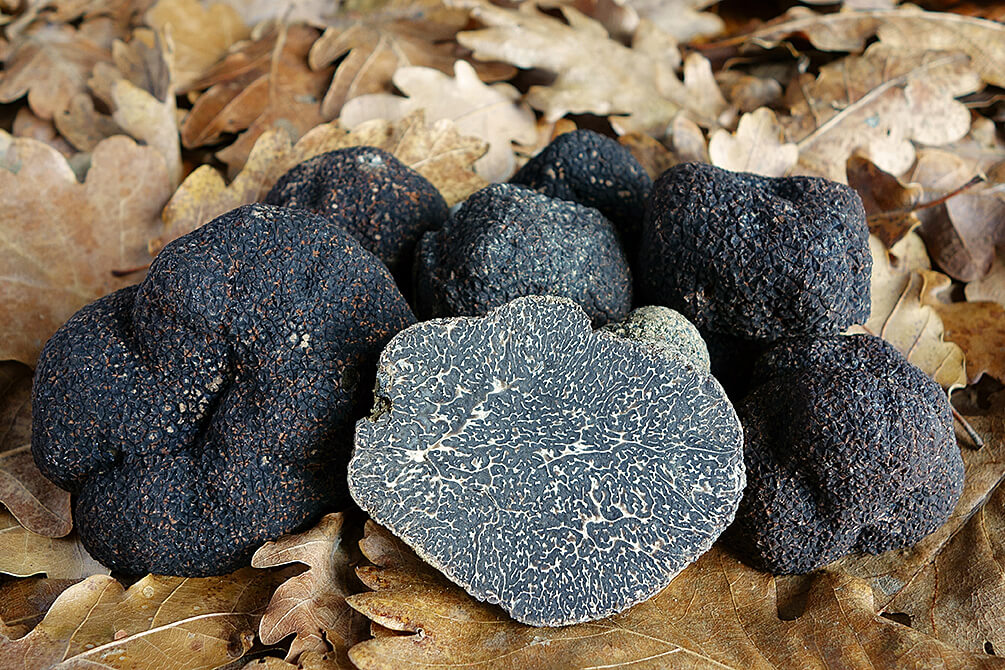
European white truffles can sell for as much as €5000 a kg, making them and their fellow fungi the most expensive food in the world. In Spain, the black truffle of Teruel oscillates between €500 and €1000 kg and is considered one of the finest in the world. However, if you are looking for a very special touch to your meal, this is it.
Truffles are hypogynous fungi. This class of fungi needs to join to the thinnest roots of certain superior plants such as holm oaks without which they are unable to live, a natural symbiosis. The life of a truffle is linked to that of the symbiont tree it lives with. Truffles have a balloon-like shape, rough and irregular and variable in size and weight. Their aspect and size depend on the season: in spring you can hardly see them, in summer they are bigger in size and pale red in colour and by the end of the autumn they start to mature and get brown and black with reddish spots first and totally black by the end of the season.
Nowadays, over a hundred truffle species are known around the world, however, only a few of them are edible and appreciated. In the province of Teruel, there are two kinds of truffles that are harvested.
Firstly, the Tuber Melanosporum Vitt, which is commonly known as Winter black truffle or Black truffle of Teruel. The body of the black truffle normally has the size of a walnut or a tennis ball, rounded or irregular and lobed. The flesh of the black truffle is thick, compact and grey or violet coloured. It has very thin white veins, clearly marked and branched. They give off a characteristic smell, which is intense and pleasant, and their taste is unique, unmistakable and characteristic. The harvesting season of this truffle has just started and continues until March. It is the black truffle variety, which is most valued in the market, due to its culinary value.
Secondly, there is the Tuber Aestivum Vitt which is also known as Summer white truffle. It can be variable in size; from a walnut to a tennis ball. It also has a round or irregular shape, as the black truffle, but sometimes with small concavities.
The main difference between Tuber Aestivum Vitt. and Tuber Melanosporum Vitt. is their inner part or flesh (gleba). The Tuber Aestivum Vitt also has a thick and fleshy gleba but it is white, yellow or ivory coloured. The smell and flavour of the summer truffle are also pleasant and characteristic, though less strong. This truffle has less culinary value and it is considered Tuber Melanosporum’s younger sister, so to speak and is harvested between May and August.


These two species must not be confused with other truffle substitutes that are also in the market and their culinary quality cannot be compared to cheaper species. You should check the label when you buy a truffle, as it should state the species and Latin name.
The Black truffle of Teruel is considered one of the best truffles in the world. The Mediterranean climate of Teruel, characterised for being extreme, moderately warm and dry, with cold winters owing to the altitude, promotes the growth of suitable vegetation. Although dry, Teruel receives the necessary rainfall that combined with the arid and chalky soil and the experience of the farmers, makes Teruel the Spanish province with the best conditions for producing high-quality truffles.
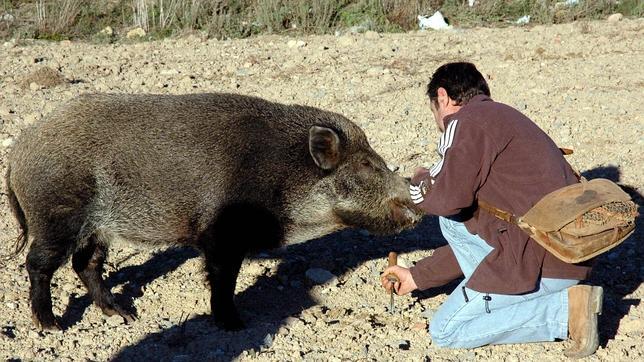
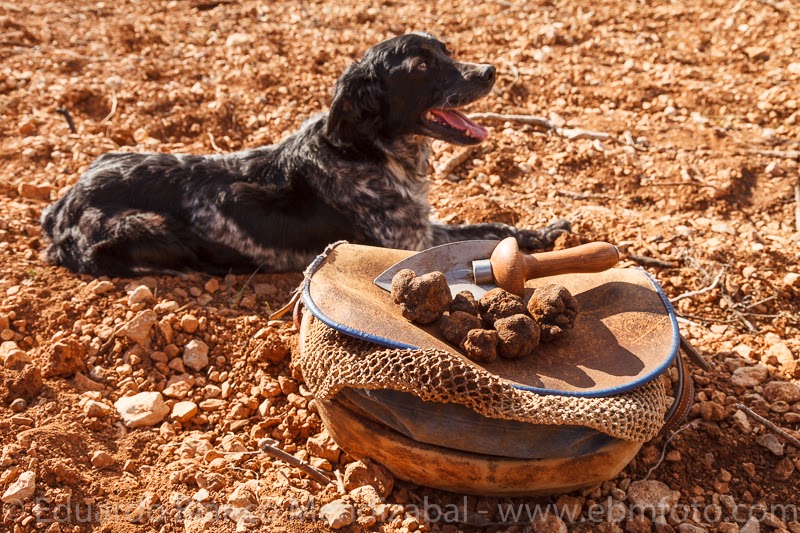
The truffle of Teruel, which is a subterranean fungus, is harvested with the aid of dogs that have been previously trained for this hard job. They can be different kinds of pure breed or cross-breeds, such as a Pointer or a Labrador retriever. The dog must be young, affable and obedient, medium-sized if possible and with hard hair to resist the low temperatures and the continuous rubbing up against the shrubs. Training a dog to find truffles is not an easy task and requires a lot of patience. The dog’s training begins with games: basically, you throw objects and then the dog has to find them and bring them back to you. Normally balls made up of clothes hiding a small portion of truffle inside are used. The animal also needs to be stimulated by eating small portions of truffle, so that it gets familiar with the smell of the valuable fungus.
Afterwards, the trainers will hide truffles under the soil several hours before the daily training session. This is done so that the smell of the truffle impregnates the soil and this way it resembles the real conditions of nature.
Every day, at the beginning of the training session, the dog is taken to the place where the truffle was hidden some hours before and then the animal is encouraged to search and scratch the land. When the dog finds the truffle it will be shown the fungus and allowed to smell it. Then, the dog is rewarded, which could be anything from a piece of bread to very small bits of cheese, dry food or even a portion of its favourite treat. The dog needs to be stimulated with patting and games; however, it is never forced too much as it can get tired soon. Little by little, the smell of the truffle will become familiar to the dog and it will need 2 or 3 years of training and practise before it becomes a “professional seeker” of truffles. We all know that pigs were used in the past, but there was no way of training them not to eat their finds…so dogs were employed.
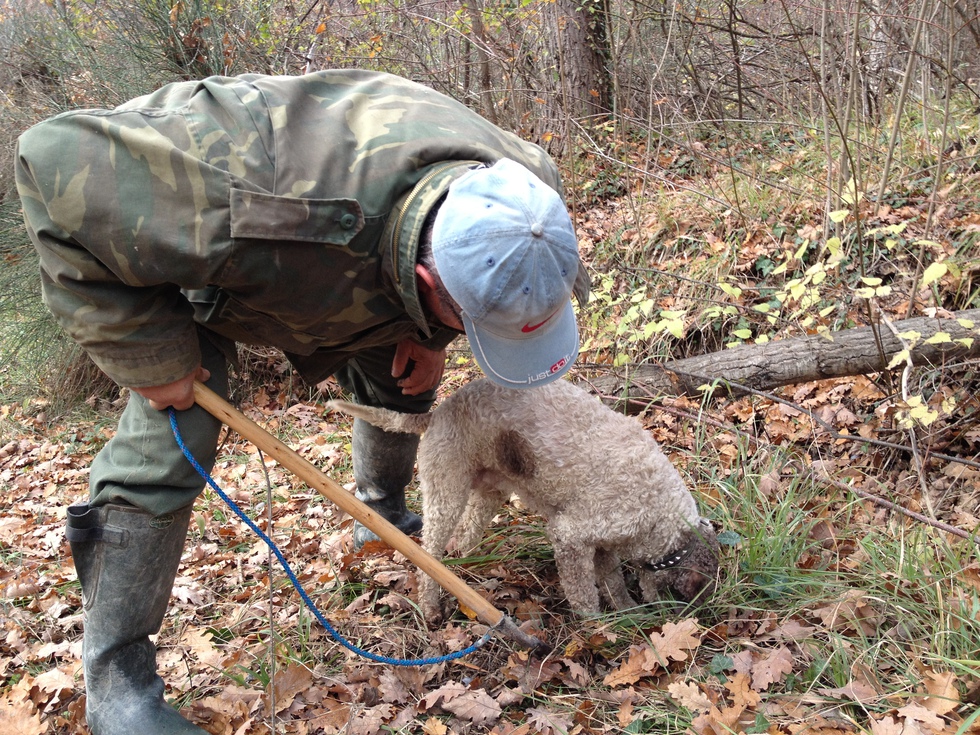
When a dog is searching out a truffle it goes around the producer trees with its nose stuck to the soil until it detects where the mature truffle is, then the dog scratches into the earth with its front legs until the order to stop is heard. The harvester extracts the truffle with the aid of special machetes; narrow machetes that are not pointed. He will dig carefully and unearth the truffle, covering again the hole with the same earth extracted before and after showing it to the dog he will give it a reward. The dog will not detect the truffle until it is sufficiently mature. Thus, it can pass over the truffle several times but never show any indication that the truffle is there.
As it is consumed in small amounts, its nutritional value is a secondary issue. However, this is a low-calorie food, with just 30 calories per 100gr, very digestive and many would say famous for its aphrodisiac powers…
The black truffle of Teruel turns any simple recipe into an exquisite delicacy, which is just unforgettable. This delicacy is treasured by the most demanding gurus of the national and international cuisine and by lovers of good gastronomic dishes. Its peculiar smell and taste, which has a strong personality, should not be mixed with other kinds of food that would mask its characteristics, for instance, garlic or vinegar.
If you use a black truffle to prepare a hot dish, it should be added at the end, as it does not require much cooking. This truffle combines well with red meat, all kinds of game, pasta, rice, eggs and so on.
But I will share a very simple truffle sauce to accompany a rib-eye steak or an “entrecote de buey” in Spain.
You will need for four servings:
250ml of liquid cream
2 shallots
2 tsp. of butter
10gr of Teruel black truffle (finely grated)
 12.56.28 - Copy 1.png)
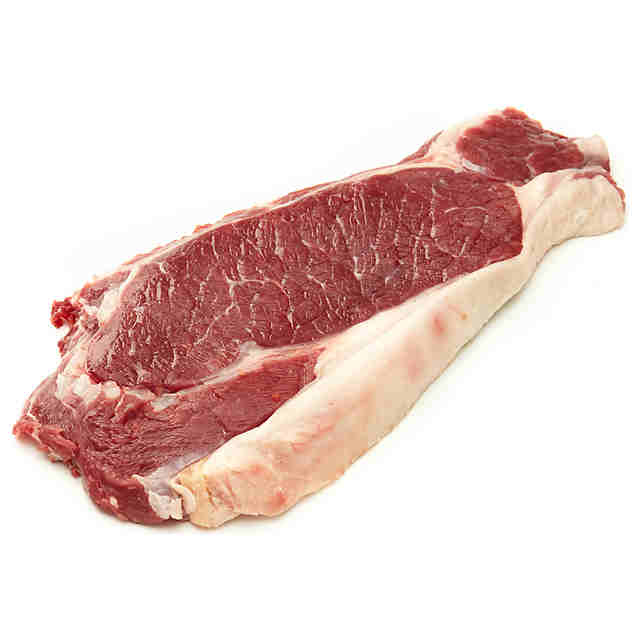

Simply dice up the shallots, melt the butter in a small frying pan and pop them in, cook them for about 4-5 minutes and then add the cream. Then just add the finely grated truffle and stir the cream for a couple of minutes. Make sure you do this once the steaks are almost ready, the truffle doesn’t need much cooking time and it will continue to cook in the hot cream if you leave it standing for too long. Pour the sauce over the steak and serve with chips or steamed vegetables.
Enjoy.